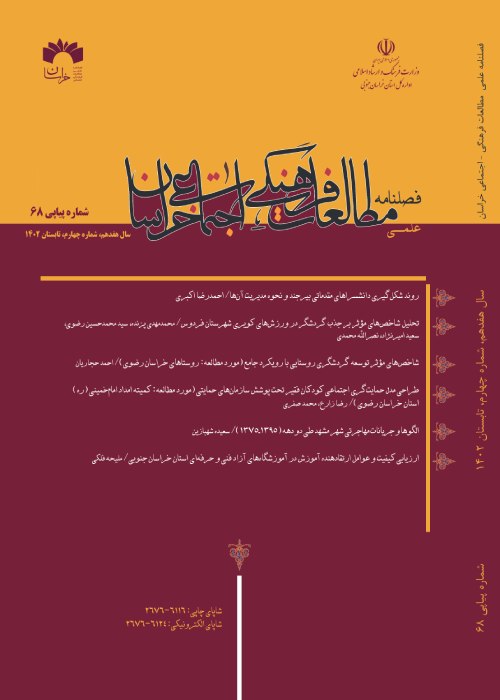Evaluation of The Quality and Factors Promoting Education in Private Technical and Vocational Institutes of South Khorasan
Today, the training of skilled, specialized, and efficient human resources is considered one of the key and undeniable factors in the economic and social development of any country (Amini, 2012, p. 83) and planners and managers of different countries have a special focus on human resource development. Among the various educational organizations in the country, the Vocational and Technical Training Organization operates in two areas, training skilled and semi-skilled labor for the training of unemployed job seekers without skills and upgrading the skills of employed labor (Akhlaghpour, 2019, p. 86). According to the general policies of the country in the field of privatization and the need to accelerate the expansion of educational services with the approach of greater participation of the non-governmental sector, private vocational and technical schools, alongside the public sector, provide vocational training. In recent years, due to the quantitative growth of these centers and the importance of flexibility and the ability to quickly adapt the provided training to the needs of the labor market, attention to quality in private vocational and technical schools has become more important. The focus of attention to quality in these trainings includes missions and general missions, inputs, processes, outputs, and its outcomes (Subrahmanyam, 2020, p. 21). In this regard, the approaches to educational quality improvement in these centers must be updated and reviewed in line with the advancement of new technologies (Sadeghfar, 2012, p. 5). Therefore, in this study, the factors affecting the improvement of quality and the factors that improve education in private vocational and technical schools of South Khorasan province from the perspective of trainees have been identified and analyzed, and suggestions for improving the quality of their activities have been provided.
This study employed an exploratory and descriptive-correlational research method. With a practical purpose and field-based data collection, the study was conducted in South Khorasan province. A sample of 217 individuals was drawn from a population of 3,123 trainees participating in private institutes’ training courses using simple random sampling. A researcher-developed questionnaire, using a Likert scale format (ranging from very low=1 to very high=5), served as the research tool. To assess validity, the questionnaire underwent multiple phases and was provided to experts, trainers, and managers of private institutes for feedback. Based on their input, the final questionnaire was finalized. Reliability was determined using Cronbach's alpha coefficient, which yielded a value of 0.96, indicating a high level of instrument reliability. Data analysis was performed in two stages: descriptive and inferential statistics using SPSS (version 27). Descriptive statistics included frequency distribution, mean, dispersion indices, etc., while the ISDM formula classified the quality status of private institutes from the trainees’ perspective into four levels. Inferential statistics involved correlation coefficients to examine the relationship between variables and t-tests and F-tests for group comparisons, as per the hypotheses and data type. Factor analysis was used to categorize the factors influencing private institutes' quality and identify them.
The study used the ISDM formula to assess the quality status of private institutes from the perspective of trainees. The results showed that 57.2% of the sample considered the quality of private institutes to be inappropriate or relatively inappropriate. The analysis revealed a significant positive relationship between the age of trainees and their perception of education quality, and a significant difference in perspectives between male and female trainees, with female trainees evaluating the quality more positively. The study also employed exploratory factor analysis with a data reduction approach. The Kaiser-Meyer-Olkin measure and Bartlett's test confirmed the suitability of the data for factor analysis. Five influential factors affecting the quality of education in private institutes were identified, explaining almost 46.5% of the variance. These factors included trainers' potentials and professional capabilities, effective educational management, and three other factors, each contributing to the overall understanding of the quality of education from the trainees' perspective. In today's organizations, particularly educational institutions, a focus on quality is paramount. With the ever-evolving technological landscape and the changing needs of stakeholders, continuous review and revision of quality standards are essential. This is especially emphasized in technical and vocational education due to its adaptability to the job market's demands. As a result, it's crucial to assess training programs to ensure the quality of education provided. If any deficiencies are identified, steps should be taken to address them.
In today's organizations, particularly educational institutions, a focus on quality is paramount. With the ever-evolving technological landscape and the changing needs of stakeholders, continuous review and revision of quality standards are essential. This is especially emphasized in technical and vocational education due to its adaptability to the job market's demands. As a result, it's crucial to assess training programs to ensure the quality of education provided. If any deficiencies are identified, steps should be taken to address them. Research findings suggest that the quality of private institutes, as perceived by trainees, is not at a desirable level. Trainees highlighted the importance of trainers' professional capabilities, effective educational management, innovative teaching methods and tools, trainee participation and interaction, as well as workplace materials and environment. Therefore, attention should be given not only to the experience and expertise of trainers and managers, but also to their interest, creativity, and initiative in recruitment. Given that trainers work with adult learners, it's important to provide opportunities for them to undergo pedagogical training courses for effective adult education before or during their service. Additionally, creating a conducive learning environment through participatory and learner-centered approaches, and fostering a positive rapport between trainees and trainers, will facilitate ongoing and precise monitoring of educational outcomes.
- حق عضویت دریافتی صرف حمایت از نشریات عضو و نگهداری، تکمیل و توسعه مگیران میشود.
- پرداخت حق اشتراک و دانلود مقالات اجازه بازنشر آن در سایر رسانههای چاپی و دیجیتال را به کاربر نمیدهد.



